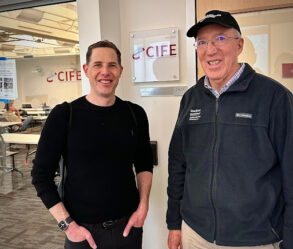Venture West Preview
If you spend any time in the AEC Digital Revolution emerging tech sector in the Bay Area, you will undoubtedly hear about Stanford University and its central role in sparking all manner of innovation in the design and construction industry, particularly in the industry’s digital revolution.
As tempting as it may be to write off the boasting of locals about their local institutions, in this case, one has to step back and recognize how incredibly fertile Stanford University has been in the AEC industry’s innovation economy, dating back to the founding of the Center for Integrated Facilities Engineering (CIFE) in 1988 through the advent of BIM, early Ai initiatives, helping launch a whole class of early venture backed startups in the ecosystem, and now in areas including sustainability, robotics and offsite construction. It is truly an impressive, multi-decade record of leading innovation, and Blackhorn Ventures’ Ray Levitt - now a professor emeritus still teaching at Stanford - who has been at the center of this pace-setting university program for more than 30 years.
Also critical to CIFE's success are Paul Teicholz, the first executive director of CIFE in 1988, who built up the membership to a sustainable level and launched its seed research program, and Martin Fischer, who has guided CIFE’s research on applications of parametric engineering and AI since 2001, and extended CIFE’s impact through increased global membership and outreach.

Although Levitt started on faculty at Stanford in the Civil Engineering Department, he has devoted significant focus over his career to questions of finance and projects, founding a group called the Global Projects Center that examines finance structures for major projects.
To an extent, his interest in finance and construction intersected again when he noticed students in the Engineering School interested in entrepreneurship and new ventures. Responding to this interest, Levitt launched a course entitled “Venture Creation for the Real Economy.” Even after retiring in 2017 and becoming operating partner of leading sector-focused venture capital fund Blackhorn Ventures, Levitt continues to teach the course to students today.
We asked one former Stanford Construction and Sustainability student about the course, and he estimated that as many as one in three students from it has opted into the startup side of the industry. Another, Rhumbix co-founder Zach Scheel, who completed the course himself, rattled off seven startups he believed had “launched out of the class,” including ScopeAR, KitSwitch, Aurora Solar, Mango Materials and Rhumbix. If these reports are even close to the truth, it is hard to think of any other institution around the world that has been as closely associated with so many of the industry’s startups.
Interested in meeting the players?
Get your ticket to the premier symposium for innovators and investors driving AEC tech.
Last call for Venture West 2024!
Beyond the startups and venture nexus, CIFE students and faculty are involved in an exhaustive array of pursuits related to innovation across the full life cycle and all end markets in the sector.

Levitt led us on a tour of the extensive areas of investigation underway on campus, starting with the building itself, which serves as an early test bed for net-zero efforts in otherwise high energy-consuming lab buildings. Levitt points out louvers on one hand and atriums on the other that harness outside air to serve as natural cooling intakes and conduits for the building, relating stories of triumphs, as well as stumbles and learning moments, with almost equal pride in both.
We saw research underway on everything from carbon reduction in existing buildings to robotics in construction to sustainability in affordable housing creation to extending the life of prefabricated buildings to correlating sustainability efforts with corporate stock performance.
Today, Levitt devotes more time to his venture fund, Blackhorn Ventures. The firm has invested in a range of built world startups that extend well beyond the Stanford community - and beyond the United States - such as Briq, Toggle, Hyperframe and EcoWorks.
But even at Blackhorn, Levitt’s ties and devotion to Stanford and the surrounding community are evident. In addition to being an investor in Scheel’s Rhumbix, the fund is invested in Alice Technologies, founded and led by Stanford adjunct professor Rene Markos, and Ray’s fellow operating partner, Jack Fuchs, is also a Stanford alum.
All told, while the industry venture investment-fueled renaissance may have emanated from Silicon Valley, and the ties to Stanford University may remain unmistakably strong, Levitt, his fund and the movement he helped spark now reverberate around the globe.

Discussion
Be the first to leave a comment.
You must be a member of the BuiltWorlds community to join the discussion.